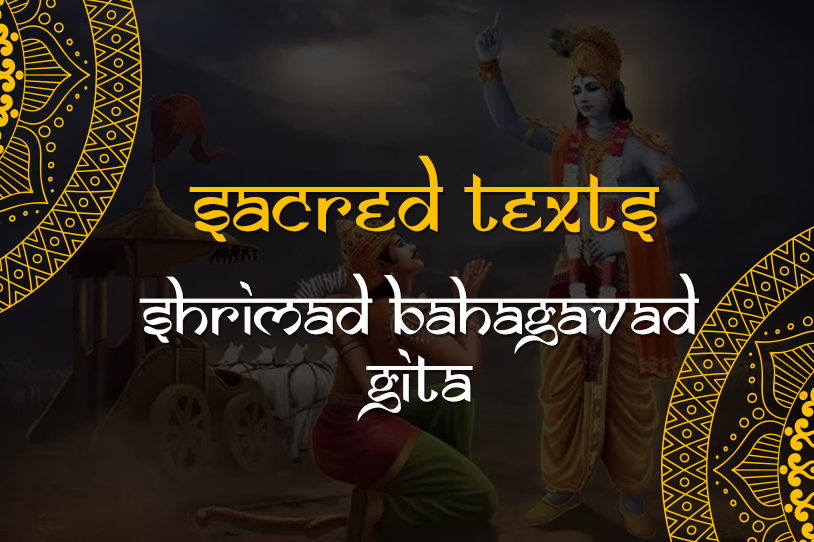
Sri Bhagwad Gita
The Bhagwad Gita is the most scared book of the Hindus spanning centuries and forms a part of the Epic Mahabharata. It is presented as a dialogue between Bhagwan Krishna and his disciple Arjuna on the eve of the war between the Pandavas & the Kauravas It is believed that the Gita was composed around the 5th century BCE and literally means “The song of God”. It presents a synthesis of Hindu ideas about Dharma, Bhakti, Karma and the Raja Yogas and teaches us how to live life with the right attitude that ultimately leads us to discover our purpose and live it fully.
The Language of the Gita
The Bhagavad Gita was recorded and presented to us in Sanskrit, India’s historic language. This is decidedly befitting as Sanskrit possesses a highly
evolved vocabulary for expressing spiritual concepts. It also has the most perfect grammar amongst all the languages of the world; a grammar that has
remained unchanged for thousands of years.
Essence of Sri Bhagwad Gita
The Bhagavad Gita not only provides a lofty philosophical understanding; it also describes clear-cut techniques for implementing its spiritual
precepts for everyday life. These techniques of applying the science of spirituality in our lives are termed “Yog.” Hence, the Bhagavad Gita is also
called “Yog Śhāstra,” meaning, the scripture that teaches the practice of Yog.
All its eighteen chapters are designated as different types of Yog because they deal with methodologies for the application of spiritual knowledge to
practical life. These chapters also describe various systems of Yog, such as Karm-yog, Jnana Yog and Bhakti-yog.
Numerous eminent Hindu holy men have studied, understood, and realized the truths of the Prasthana Trayi before writing commentaries on these
sacred Hindu texts in order to make their meaning clear.
Saints who have written a commentary on the Prasthani Trayi that is accepted as masterpieces by other leading Hindu holy men and religious
scholars of that time and are considered a great authority on Hinduism are Sri Sri Adi Shankaracharya, Sri Ramanujacharya, and Sri Madhvacharya.
These three saintly scholars are the most recent among the evolved souls who have written commentaries on the Gita and other great spiritual
books around 800 years to 1500 years ago.
Course Details
Chapter 1- Arjun Viṣhād Yog: Lamenting the Consequences of War
Chapter 2- Sānkhya Yog: The Yog of Analytical Knowledge
Chapter 3- Karm Yog: The Yog of Action
Chapter 4- Jñāna Karm Sanyās Yog: The Yog of Knowledge and the Disciplines of Action
Chapter 5-Karm Sanyās Yog: The Yog of Renunciation
Chapter 6- Dhyān Yog: The Yog of Meditation
Chapter 7- Jñāna Vijñāna Yog : Yog through the Realization of Divine Knowledge
Chapter 8- Akṣhar Brahma Yog: The Yog of the Eternal God
Chapter 9- Rāja Vidyā Yog: Yog through the King of Sciences
Chapter 10- Vibhūti Yog: Yog through Appreciating the Infinite Opulences of God
Chapter 11- Viśhwarūp Darśhan Yog: Yog through Beholding the Cosmic Form of God
Chapter 12- Bhakti Yog: The Yog of Devotion
Chapter 13- Kṣhetra Kṣhetrajña Vibhāg Yog: Yog through Distinguishing the Field and the Knower of the Field
Chapter 14- Guṇa Traya Vibhāg Yog: Yog through Understanding the Three Modes of Material Nature
Chapter 15- Puruṣhottam Yog: The Yog of the Supreme Divine Personality
Chapter 16- Daivāsura Sampad Vibhāg Yog: Yog through Discerning the Divine and Demoniac Natures
Chapter 17- Śhraddhā Traya Vibhāg Yog: Yog through Discerning the Three Divisions of Faith
Chapter 18- Moksha Sanyās Yog: Yog through the Perfection of Renunciation
This course will provide the student with a holistic and insightful coverage of the entire text in a simple and lucid way that can be absorbed and
assimilated easily.
It will give input for continuous improvement and a practical guide to live and practice a more meaningful life and aims to harmoniously blend the
subject matter of the Bhagavad Gita with the subjective disciplines of spirituality. Both these aspects in conjunction with each other will enable a
student to understand and internalize teachings of the Gita and actively live by it.
The purpose of Bhagavad Gita is to deliver mankind from the shackles of material existence. The subject entails the comprehension of five basic
truths, it will address in full about the following topics :
• Isvara – The Supreme Controller, God.
• Jivas – The living entities which are being controlled.
• Prakriti – The cosmic manifestation, the material nature.
• Kala – The time, the duration of the existence of the whole universe.
• Karma – The activities of the living entities.
The course consists of 36 sessions delivered on twice weekly basis, where Sanskrit terms will be clarified and students can look forward to the
traditional commentaries on the Gita.
They will also reflect on the relevance of the Gita to the modern world.
Within this course, you will study the main themes of Krishna’s teachings and the principles, ideas, and theories within the 18 chapters, or 700
verses, of Bhagavad Gita.
Duration: 36 Weeks
Charges: 108$
Group charges- Pay as you wish
Copyright ©2022 KTGurukulam. All Rights Reserved

